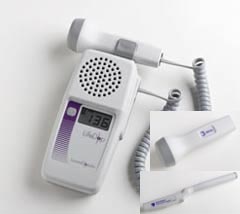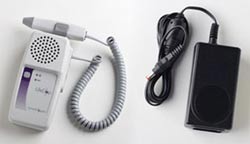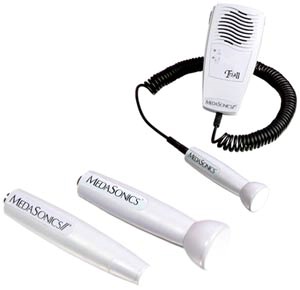Home » Hospital & Durable Medical Equipment » Ultrasound Machines » Ultrasound Machines
Ultrasound Machines

2 Ultrasound Doppler Probe Obstetrical Combination
Retail Price: $1,108.80
Your Price: $939.99
 Unit: single
Unit: single

Non Display-Handheld Ultrasound Doppler w/ Recharger
Retail Price: $639.03
Your Price: $539.91
 Unit: single
Unit: single
Ultrasound machines are a widely used piece of medical equipment, implemented by doctors from many different fields. While most associate them with obstetrics, they are also used to image the heart and circulatory systems as well as in the field of urology. Any physician worth his salt knows that having a reliable ultrasound machines that is easy to use and interpret could mean the difference between a positive or negative diagnosis. A mistake such as that could cost the patient his life, and the practitioner his livelihood.
Ultrasound machines work on basic principals. These machines act in the same way that bats do when they fly. First, the machines sends out high frequency sound waves into the body. These waves all travel at the same speed until they come to some sort of a differential. This might be where bone meets tissue or fluids meet tissue. At this border, some of the waves are reflected back to the ultrasound machines, while others continue on. Once all the waves have returned, the machine determines the distance of the borders by using the length of time that the waves took to return, the intensity of the wave, and the density of tissue. All of this happens in micro-seconds, and the results appear instantaneously. The screen of the ultrasound machines then shows these distance differences and the intensities usually as a two-dimensional image. The view of the image can be changed simply by moving the probe around or changing its angle.
There are two other types of ultrasound machines. One of which is the doppler machine. This uses the same principal behind doppler radar to image the interior of the body. Rather than using the time and intensities of returned sound waves, doppler machines use the frequencies. A wave that returns with a higher frequency means means that the object is moving toward the probe, and a lower frequency indicates movement away. The change in frequency determines the speed of the object. This is a helpful tool in the field of cardiology for measuring blood as it flows through the circulatory system.
Another kind is the 3-D imaging ultrasound equipment. This compiles many two dimensional images gathered by either inserting the probe into the body or by changing its angle outside. Dozens of 2-D readings are fed into a computer that does the calculations to give a three dimensional readout. This type of ultrasound machines has proven invaluable to obstetricians looking at fetuses and oncologists examining tumors.
Imaging is also likely to improve as well, but for now, it is vital that the doctor has a quality ultrasound machines. This will offer the clearest readout as well as having the ability to print the images. Obstetricians already know how important the printer is, since every mother-to-be wants a copy from the ultrasound machines as her first baby picture. A hard copy is also a useful backup for any imaging session, in case computer files are destroyed or lost. Due to their diagnostic nature, ultrasound machines are not likely to diminish in their use or popularity. As more and more improvements are made especially in 3-D and doppler, physicians will find more uses for them, and not having one in the office will be seen as a detriment to the patient.















